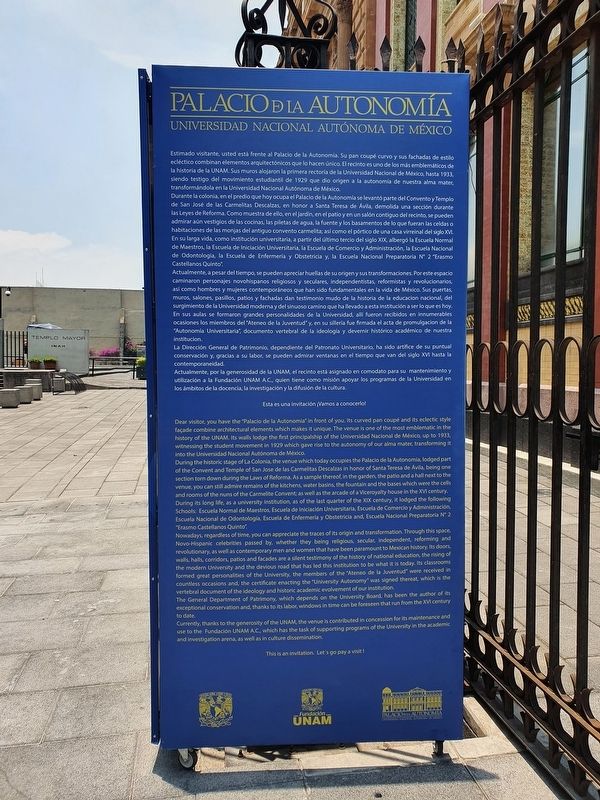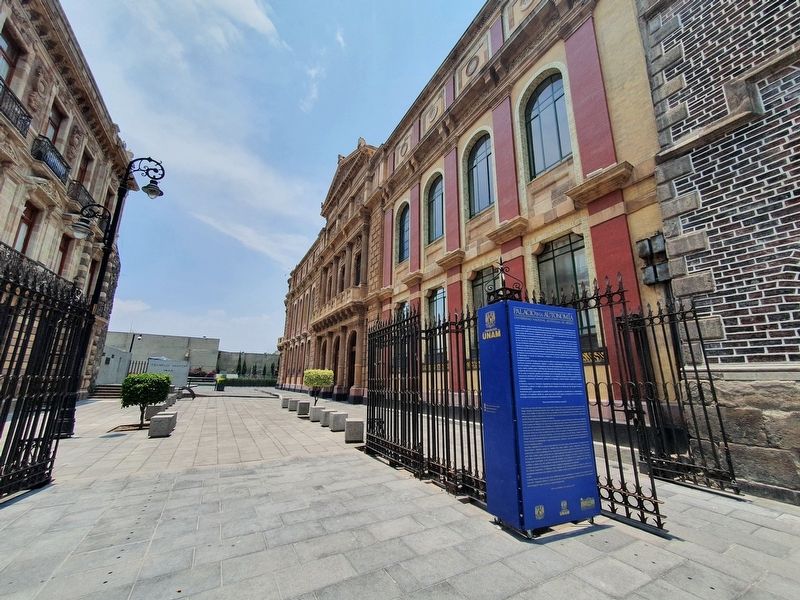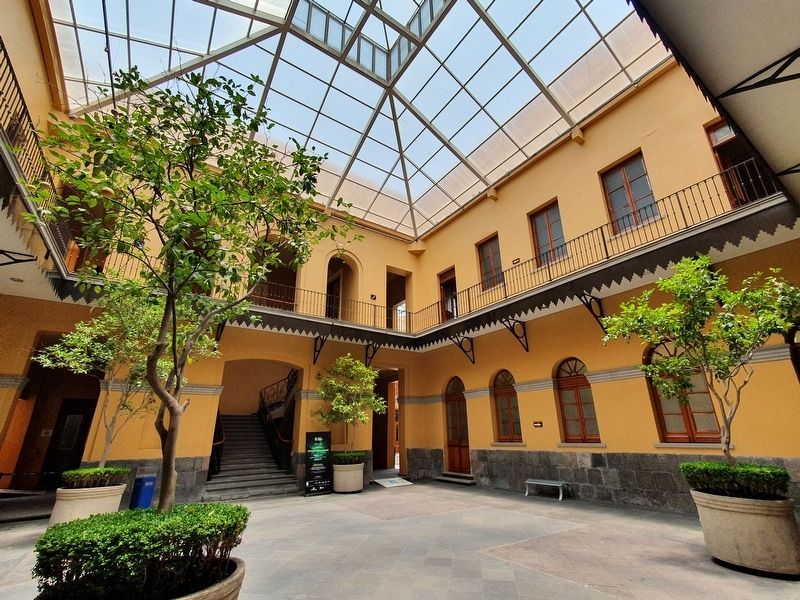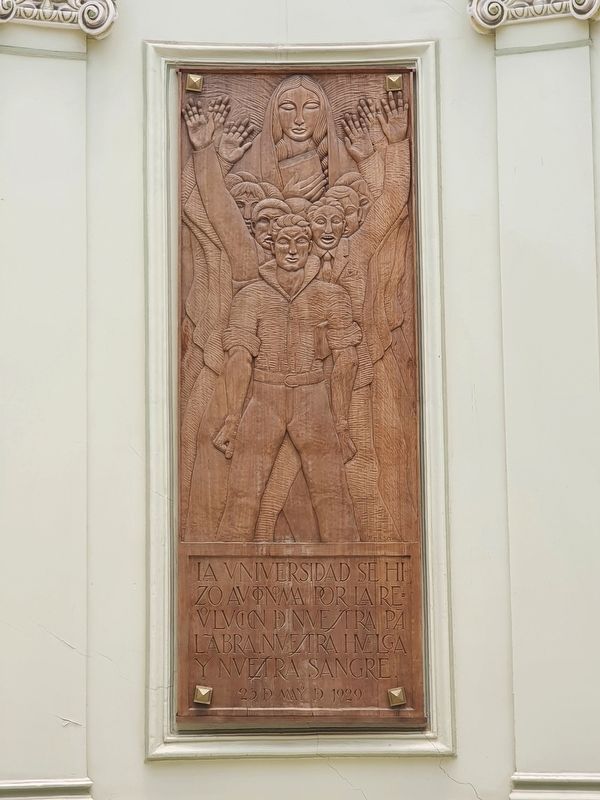Centro Histórico in Ciudad de México, Mexico — The Valley of Mexico (The Central Highlands)
Palacio de la Autonomía
Universidad Nacional Autónoma de México
Estimado visitante, usted está frente al Palacio de la Autonomia. Su pan coupé curvo y sus fachadas de estilo ecléctico combinan elementos arquitectónicos que lo hacen único. El recinto es uno de los más emblemáticos de la historia de la UNAM. Sus muros alojaron la primera rectoria de la Universidad Nacional de México, hasta 1933, siendo testigo del movimiento estudiantil de 1929 que dio origen a la autonomia de nuestra alma mater, transformándola en la Universidad Nacional Autónoma de México.
Durante la colonia, en el predio que hoy ocupa el Palacio de la Autonomia se levantó parte del Convento y Templo de San José de las Carmelitas Descalzas, en honor a Santa Teresa de Avila, demolida una sección durante las Leyes de Reforma. Como muestra de ello, en el jardin, en el patio y en un salón contiguo del recinto, se pueden admirar aún vestigios de las cocinas, las piletas de agua, la fuente y los basamentos de lo que fueran las celdas o habitaciones de las monjas del antiguo convento carmelita; así como el pórtico de una casa virreinal del siglo XVI. En su larga vida, como institución universitaria, a partir del último tercio del siglo XIX, albergó la Escuela Normal de Maestros, la Escuela de Iniciación Universitaria, la Escuela de Comercio y Administración, la Escuela Nacional de Odontologia, la Escuela de Enfermería y Obstetricia y, la Escuela Nacional Preparatoria N° 2 "Erasmo Castellanos Quinto”.
Actualmente, a pesar del tiempo, se pueden apreciar huellas de su origen y sus transformaciones. Por este espacio caminaron personajes novohispanos religiosos y seculares, independentistas, reformistas y revolucionarios, así como hombres y mujeres contemporáneos que han sido fundamentales en la vida de México. Sus puertas, muros, salones, pasillos, patios y fachadas dan testimonio mudo de la historia de la educacion nacional, del surgimiento de la Universidad modera y del sinuoso camino que ha llevado a esta institución a ser lo que es hoy. En sus aulas se formaron grandes personalidades de la Universidad, alli fueron recibidos en innumerables ocasiones los miembros del "Ateneo de la Juventud" y, en su silleria fue firmada el acta de promulgacion de la "Autonomia Universitaria”, documento vertebral de la ideologia y devernir histórico académico de nuestra institucion.
La Dirección General de Patrimonio, dependiente del Patronato Universitario, ha sido artifice de su puntual conservación y, gracias a su labor, se pueden admirar ventanas en el tiempo que van del siglo XVI hasta la contemporaneidad.
Actualmente, por la generosidad de la UNAM, el recinto está asignado en comodato para su mantenimiento y utilización a la Fundación UNAM AC, quien tiene como misión apoyar los programas de la Universidad en los ámbitos de la docencia, la investigación y la difusión de la cultura.
Esta es una invitación ¡Vamos a conocerlo!
Palacio de la Autonomía
Universidad Nacional Autónoma de México
Dear visitor, you have the "Palacio de la Autonomia" in front of you. Its curved pan coupé and its eclectic style façade combine architectural elements which makes it unique. The venue is one of the most emblematic in the history of the UNAM. Its walls lodge the first principalship of the Universidad Nacional de México, up to 1933, witnessing the student movement in 1929 which gave rise to the autonomy of our alma mater, transforming it into the Universidad Nacional Autónoma de México.
During the historic stage of La Colonia, the venue which today occupies the Palacio de la Autonomia, lodged part of the Convent and Temple of San Jose de las Carmelitas Descalzas in honor of Santa Teresa de Avila, being one section torn down during the Laws of Reforma. As a sample thereof, in the garden, the patio and a hall next to the venue,
you can still admire remains of the kitchens, water basins, the fountain and the bases which were the cells and rooms of the nuns of the Carmelite Convent; as well as the arcade of a Viceroyalty house in the XVI century. During its long life, as a university institution, as of the last quarter of the XIX century, it lodged the following Schools: Escuela Normal de Maestros, Escuela de Iniciación Universitaria, Escuela de Comercio y Administración, Escuela Nacional de Odontologia, Escuela de Enfermería y Obstetricia and, Escuela Nacional Preparatoria N°2
"Erasmo Castellanos Quinto”.
Nowadays, regardless of time, you can appreciate the traces of its origin and transformation. Through this space, Novo-Hispanic celebrities passed by, whether they being religious, secular, independent, reforming and revolutionary, as well as contemporary men and women that have been paramount to Mexican history. Its doors, walls, halls, corridors, patios and facades are a silent testimony of the history of national education, the rising of the modern University and the devious road that has led this institution to be what it is today. Its classrooms formed great personalities of the University, the members of the "Ateneo de la Juventud" were received in countless occasions and, the certificate enacting the "University Autonomy" was signed thereat, which is the vertebral document of the ideology
and historic academic evolvement of our institution.
The General Department of Patrimony, which depends on the University Board, has been the author of its exceptional conservation and, thanks to its labor, windows in time can be foreseen that run from the XVI century to date.
Currently, thanks to the generosity of the UNAM, the venue is contributed in concession for its maintenance and use to the Fundación UNAM A.C., which has the task of supporting programs of the University in the academic and investigation arena, as well as in culture dissemination.
This is an invitation. Let's go pay a visit!
Erected by Fundación UNAM.
Topics. This historical marker is listed in these topic lists: Architecture • Colonial Era • Education. A significant historical year for this entry is 1933.
Location. 19° 26.056′ N, 99° 7.848′ W. Marker is in Ciudad de México. It is in Centro Histórico. Marker is on Licenciado Verdad just north of Moneda, on the right when traveling north. Touch for map. Marker is at or near this postal address: Lic Verdad 3, Ciudad de México 06000, Mexico. Touch for directions.
Other nearby markers. At least 8 other markers are within walking distance of this marker. Ex Teresa Arte Actual (here, next to this marker); Baroque Entryway (within shouting distance of this marker); History of the Convent (within shouting distance of this marker); Colonial Arch and Platform from Phase V (within shouting distance of this marker); South Red Temple (within shouting distance of this marker); Templo Mayor Museum (within shouting distance of this marker); Eastern Border of the Sacred Center (within shouting distance of this marker); Commemorative Dates in the Great Temple (within shouting distance of this marker). Touch for a list and map of all markers in Ciudad de México.
Credits. This page was last revised on February 7, 2023. It was originally submitted on September 29, 2022, by J. Makali Bruton of Accra, Ghana. This page has been viewed 80 times since then and 19 times this year. Photos: 1, 2, 3, 4. submitted on September 29, 2022, by J. Makali Bruton of Accra, Ghana.



